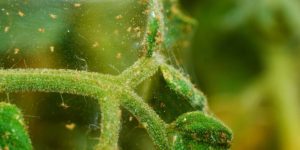Purple blotch is a fungal infection caused by the fungus Alternaria porri which can infect all above ground parts of the crop as well as the bulb. It attacks onion, garlic and other allium crops causing significant losses.
The pathogen is favoured by warm and moist environmental conditions.
Disease Cycle
- The pathogen overwinters in crop residue, on or near the soil surface.
- Spores are produced at night and released in the morning as humidity decreases, and are spread by wind or splashing rain to healthy plants to initiate infection.
- The disease symptoms appear 1-4 days after infection and black spores are produced by fresh lesions within 5 days.
Infection & Symptoms
- Initially, infection causes the development of small water soaked lesions with whitish centres, mostly on the older leaves. These lesions enlarge as infection progresses and become purplish with light yellow concentric rings on the margins.
- Leaves may turn yellowish-brown, lose erectness and eventually wilt, if the disease is not controlled.
- Younger leaves become more susceptible as the bulb matures.
- If the pathogen enters neck wounds during harvesting, bulbs can also be infected, making them to eventually become papery.
Management & Control
Considering the losses attributed to infection with purple blotch, it is recommended that the disease be controlled. Various methods can be used, which include the following;
Chemical control
The following fungicide have both preventive and curative capabilities and therefore very effective against purple blotch.
- TRINITY GOLD 425WP 50g/20l
- ABSOLUTE 375SC 10ml/20l
- COLONIZER 440WP 50g/20l
- TOWER 720WP 50g/20l
- MILLIONAIRE 690WDG 40g/20l
- GEARLOCK TURBO 250WP 25g/20l
- PYRAMID 700WP 50g/20l
- DOMAIN 250EC 10ml/20l
NB;
- Whenever spraying, it is advisable to mix the fungicide with INTEGRA 3ml/20l. This is a sticker, penetrant and spreader which improves the efficacy of the product.
- In order to prevent the pathogen from developing resistance towards any of the fungicides, it is recommended that different fungicides be alternated, instead of using a single chemical throughout the crop season.
- Always ensure timely control/ management of the pathogen.
Other methods
They include the following;
- Use of certified or disease free seeds
- Crop rotation with non-host crops
- Maintenance of field sanitation
- Proper weed control
- Use of resistance varieties






